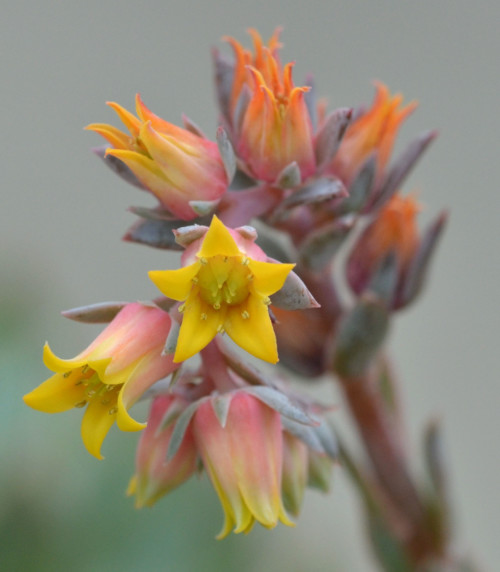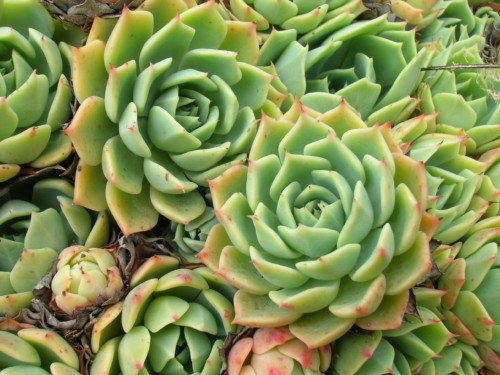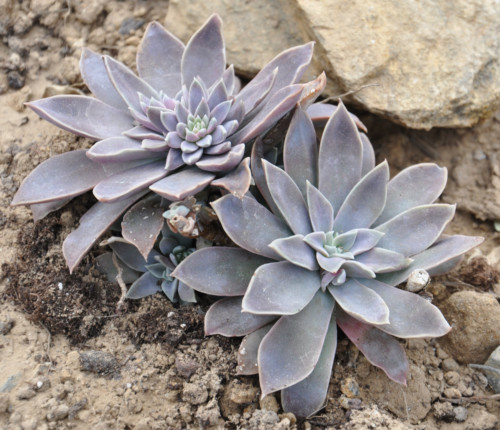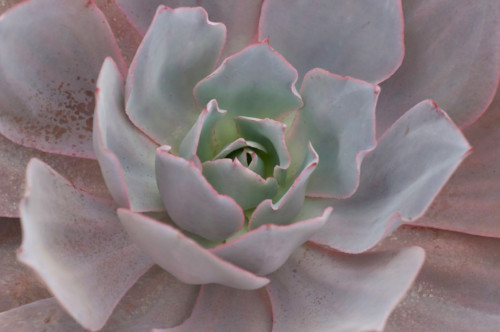Everything You Need To Know About Echeverias
Echeveria: how do we love thee? Let us count the ways…
Echeverias are rose-shaped succulents that are easy to care for, drought-resistant, and come in a beautiful variety of colors and sizes. The plant flowers readily (mostly coral-pink, yellow-tipped, or reddish-orange blooms) and grows quickly compared to other succulents, as it functions well as ground cover and does well in containers. Adaptability and beauty– what’s not to like?
Native to semi-desert regions of Mexico, the fleshy-leaved succulent has become very popular in nurseries and garden centers, especially in coastal California at specialty purveyors like Succulent Gardens in Castroville (near Monterey) and Annie’s Annuals and Perennials (in the East Bay).
“I love echeverias for their colors, from pink, green, white to red, their versatility. They’re hardy and forgiving,” says Robin Stockwell, the retired former owner and founder of Succulent Gardens, which sells 750 succulent varieties.
Echeveria’s striking appearance brings drama to a garden, centerpiece, or bouquet. “I like to do mass plantings of echeverias in several varieties, since they look so different,” says Stockwell, author of the new book [easyazon_link identifier=”0848749472″ locale=”US” tag=”gardcoll03-20″]Succulents[/easyazon_link], who began growing succulents in 1972. “If I do vertical gardening, I prefer echeveria secunda for their small rosettes. Other favorites are lipstick and ebony agavoides.”
Named for a Mexican botanical artist, Atanasio Echeveria, this Crassulaceae family plant thrives in temperatures up to 90 degrees F and down to 25 degrees F. In harsher winters, echeverias should be taken indoors or protected from frost. “Some species and hybrids are somewhat frost-tolerant, but they do best in temperate to warm-temperature gardens. It’s best to consult with a local branch of the Cactus and Succulent Society of America for what’s appropriate for your area,” says Bryan K. Gim, horticulturalist of the succulent garden at the University of California Botanical Garden at Berkeley.
“The number of succulent gardens in California compared to 10 years ago is phenomenal,” Stockwell adds. “Years ago, it was mainly a collector world. But the world changed, water consciousness increased, and landscape designers started getting interested.”
Says the editor of Pacific Horticulture, Lorene Edwards Forkner: “My take on succulent mania is that this plant category, with their graphic forms, beautiful colors, and ease of care is a horticultural gateway drug to further adventures in gardening.”
Some of Our Favorites
Echeveria secunda
Clumps of small, tight, grayish blue-green stemless rosettes that grow up to 6” tall.
Echeveria ‘Perle von Nurnberg’
Big milky-blue rosettes with pinkish highlights, named for a 1930’s German succulent grower. In summer, yellow-tipped, coral-pink flowers appear on foot-tall spikes, up to six times a year.
Echeveria agavoides
The “Lipstick” variety has bright-red-bordered green leaves in big rosettes 18” wide. The “Ebony” agavoides have big rosettes of maroon and dark purple-tipped green leaves, which are a bit wider than other varieties.
Echeveria elegans
Called the “Mexican Snowball”, echeveria elegans has rosettes of aqua or pale-green spoon-shaped leaves, which have a silvery patina up to 12” wide.
Echeveria subrigida
The “Fire and Ice” variety of echeveria subrigida has ghostly-looking white leaves with blood-red edges in big rosettes that can be 18” wide. Other subrigida types feature blue-green leaves with pink or rose tones and an iridescent sheen.
Echeveria peacockii
Silvery-blue rosettes up to 8″ wide.
Echeveria diffractens
Blackish-purple leaves in flat 12″ wide rosettes.
Echeveria colorata
Pink-tinged blue-green rosettes.
Echeveria nodulosa
Dark purple swirls on icy blue-green leaves.
Echeveria “Afterglow”
Lavender-pink leaves with pink edges in big loose rosettes 12-16″ wide– but the rosettes can turn bright rosy-pink if stressed by sea air and lots of sun.
Tips on Care
Echeverias like full sun, bright shade, and well-drained soil. Water them when the soil is dry; they often can go anywhere from 2-12 weeks without water once established. Generally, they’re grown from leaf and stem cuttings and offsets, not seeds.
“Overwatering is one of the easiest ways to prematurely end the life of your succulents,” says Debra Lee Baldwin, the Escondido, California-based author of [easyazon_link identifier=”088192816X” locale=”US” tag=”gardcoll03-20″]Designing with Succulents[/easyazon_link] and other books. “One of my favorite concepts in working with succulents is that of benign neglect – often the best strategy to keep them looking beautiful is to remember to forget about tending to them.”







































